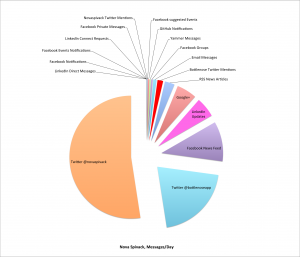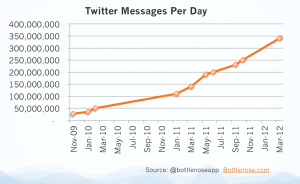This is Part II of a three-part series of articles on how the Stream is changing the Web.
In Part I of this series, The Message is the Medium, I wrote about some of the shifts that are taking place as the center of online attention shifts from documents to messages.
Here in Part II, we will explore some of the deeper problems that this shift is bringing about.
New Challenges in the Era of the Stream
Today the Stream has truly arrived. The Stream is becoming primary and the Web is becoming secondary. And with this shift, we face tremendous new challenges, particularly around overload. I wrote about some of these problems for Mashable in an article called, “Sharepocalypse Now.”
The Sharepocalypse is here. It’s just too easy to share, there is too much stuff being shared, there are more people sharing, and more redundant ways to share the same things. The result is that we are overloaded with messages coming at us from all sides.
For example, I receive around 13,000 messages/day via various channels, and I’m probably a pretty typical case. You can see a more detailed analysis here.
As the barrier to messaging has become lower and people have started sending more messages than ever before, messaging behavior has changed. What used to be considered spam is now considered to be quite acceptable.
Noise is Increasing
In the 1990’s emailing out a photo of the interesting taco you are having for lunch to everyone you know would have been considered highly spammy behavior. But today we call that “foodspotting” and we happily send out pictures of our latest culinary adventure on multiple different social networks at once.
Spam is the New Normal
It’s not just foodspotting – the same thing is happening with check-ins, and with the new behavior of “pinning” things (the new social bookmarking) that is taking place in Pinterest. Activities that used to be considered noise have somehow started to be thought of as signal. But in fact, for most people, they are still really noise.
The reason this is happening is that the barrier to sharing is much lower than it once was. Email messages took some thought to compose – they were at least a few paragraphs long. But today you can share things that are 140 characters or less, or just a photo without even any comments. It’s instant and requires no investment or thought.
Likewise, in the days of email you had to at least think, “is it appropriate to send this or will it be viewed as spam?” Today people don’t even have that thought anymore. Send everything to everyone all the time. Spam is the new normal.
Sharing is a good thing, but like any good thing, too much of it becomes a problem.
The solution is not to get people to think before sharing, or to share less, or to unfollow people, or to join social networks where you can only follow a few people (like Path or Pair), it’s to find a smarter way to deal with the overload that is being created.
Notifications Overload
Sharing is not the only problem we’re facing. There are many other activities that generate messages as well. For example, we’re getting increasing numbers of notifications messages from apps. These notifications are not the result of a person sharing something, they are the result of an app wanting to get our attention.
We’re getting many types of notifications, for example:
- When people follow us
- When we’re tagged in photos
- When people want to be friends with us
- When there are news articles that match our interests
- When friends check-in to various places
- When people are near us
- When our flights are delayed
- When our credit scores change
- When things we ordered are shipped
- When there are new features in apps we use
- When issue tickets are filed or changed
- When files are shared with us
- When people mention or reply to us
- When we have meeting invites, acceptances, cancellations, or meetings are about to start
- When we have unread messages waiting for us in a social network
The last bullet bears an extra mention. I have noticed that LinkedIn for example, sends me these notifications about notifications. Yes, we are even getting notifications about notifications!
When you get messages telling you that you have messages, that’s when you really know the problem is getting out of hand.
Fragmented Attention
Another major problem that the Stream is bringing about is the fragmentation of attention.
Today email is not enough. If it wasn’t enough work that we each have several email inboxes to manage, we are now also getting increasing volumes of messages outside of email in entirely different inboxes for specialized apps. We have too many inboxes.
It used to be that to keep up with your messages all you needed was an email client.
Then the pendulum swung to the Web and it started to become a challenge to keep up with all the Web sites we needed to track every day.
So RSS was invented and for a brief period it seemed that the RSS reader would be adopted widely and solve the problem of keeping up with the Web.
But then social networks came out and they circumvented RSS, forcing users to keep up in social-network specific apps and inboxes.
So a new class of “social dashboard” apps (like Tweetdeck) were created to keep up with social networks, but they didn’t include email or RSS, or all the other Web apps and silos.
This trend towards fragmentation has continued – an increasing array of social apps and web apps can really only be adequately monitored in those same apps. You can’t really effectively keep up with them in email, in RSS, or via social networks. You have to login to those apps to get high-fidelity information about what is going on.
We’re juggling many different inboxes. These include email, SMS, voicemail, Twitter, Facebook, LinkedIn, Pinterest, Tumblr, Google+, YouTube, Yammer, Dropbox, Chatter, Google Reader, Flipboard, Pulse, Zite, as well as inboxes in specialized tools like Github, Uservoice, Salesforce, and many other apps and services.
Alan Lepofsky, at Constellation Research, created a somewhat sarcastic graph to illustrate this problem, in his article, “Are We Really Better Off Without Email?” The graph is qualitative – it’s not based on direct numbers – but in my opinion it is probably very close to the truth.
What this graph shows is that email usage peaked around 2005/2006, after which several new forms of messaging began to get traction. As these new apps grew, they displaced email for some kinds of messaging activities, but more importantly, they fragmented our messaging and thus our attention.
The takeaway from this graph is that we will all soon be wishing for the good old days of email overload. Email overload was nothing compared to what we’re facing now.
The Message Volume Explosion
As well as increasing noise and the fragmentation of the inbox, we’re also seeing huge increases in message volume.
Message volume per day, in all messaging channels, is growing. In some of these channels, such as social messaging, it is growing exponentially. For example, look at this graph of Twitter’s growth in message volume per day since 2009, from the Bottlenose blog:
Twitter now transmits 340 Million messages per day, which is more than double the number of messages per day in March of 2011.
If this trend continues then in a year there will be between 500 million and 800 million messages per day flowing through Twitter.
And that’s just Twitter – Facebook, Pinterest, LinkedIn, Google+, Tumblr, and many other streams are also growing. And email messages are also increasing as well, thanks to all the notifications that are being sent to email by various apps.
Message volume is growing across all channels. This is going to have several repercussions for all of us.
Engagement is Threatened
First of all, the signal-to-noise ratio of social media, and other messaging channels, is going to become increasingly bad as volume increases. There’s going to be less signal and more noise. It is going to get harder to find the needles in the haystack that we want, because there is going to be so much more hay.
Today, on services like Twitter and Facebook, signal-to-noise is barely tolerable already. But as this situation gets worse in the next two years, we are going to become increasingly frustrated. And when this happens we are going to stop engaging.
When signal-to-noise in a channel gets too out of hand, it becomes unproductive and inefficient to use that channel. In the case of social media, we are right on cusp of this happening. And when this happens, people will simply stop engaging. And when engagement falls the entire premise of social media will start to fail.
This is already starting to happen. One recent article by George Colony, CEO of analyst firm, Forrester Research, cites a recent study that found that 56% of time spent on social media is wasted.
When you start hearing numbers like this, it means that consumers are not getting the signal they need most of the time, and this will inevitably result in a decrease in satisfaction and engagement.
What’s Next?
We have seen some of the issues that are coming about, or may soon come about, as the Stream continues to grow. But what’s going to happen next? How is the Stream, and our tools for interacting with it, going to adapt?




